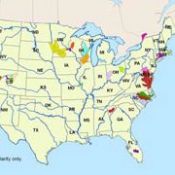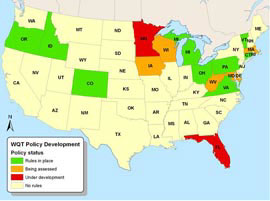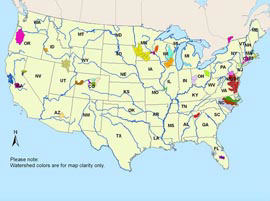US Water Trading: The Infrastructure
As governments around the world experiment with market-based solutions to water pollution, they look for lessons to those who have gone before them. The Ecosystem Marketplace examines the structure of the US water trading markets, and takes stock of the lessons learned.

As governments around the world experiment with market-based solutions to water pollution, they look for lessons to those who have gone before them. The Ecosystem Marketplace examines the structure of the US water trading markets, and takes stock of the lessons learned. Third in a Series
6 May 2008 | The United States has been experimenting with water quality trading (WQT) for more than two decades, and it’s now clear the schemes, while far from perfect, need not be a “license to pollute,” as some critics charge. Furthermore, WQT does not inevitably lead to the creation of pollution “hotspots,” nor is it a rollback of regulations, or an attempt to replace traditional permitting authorities.
On the contrary, our experience with more than 70 specific cases of WQT programs suggests that these schemes – if properly structured and implemented – can achieve environmental goals while reducing costs. You will find links to summaries and analysis of programs we feel have been done right under the heading “Water Trading: The Programs”.
Recipe for Success
WQT is an evolving discipline, but a handful of ingredients necessary for success have become apparent. The first three were enumerated by former US Environmental Protection Authority
Assistant Administrator for Water G. Tracy Mehan III in 2003: ensuring that trades create environmentally equivalent pollution reductions; ensuring that trading activity avoids hot spots (localized areas with high levels of pollution within a watershed); and ensuring that programs identify and use reliable estimation techniques for calculating nonpoint source pollution reductions.
Before delving into lessons-learned, we’d like to add two ingredients of our own: minimizing transaction costs, and making sure there’s an enforcement mechanism so that promised environmental benefits are, in fact, delivered.
This last ingredient is our first lesson-learned:
Lesson One: The Need for Authority and Clarity
One of the first lessons drawn from the US experience is that to encourage trading there needs to be clear authority to trade and clear legal protection for using the rights purchased (in the form of water quality credits) to meet established regulatory requirements.
One of the projects we’ll be examining, the Long Island Sound Nitrogen Credit Program , uses a state-sanctioned watershed permit to institute a trading program backed by state funds to guarantee trades.
Another program, the Minnesota River Basin program, incorporates point source-nonpoint trading into a legal document issued by the National Pollutant Discharge Elimination System (NPDES) to ensure the right of point sources to discharge as long as the permit provisions, including trading, are not violated. Other programs that have successfully traded pollutant reduction credits also have similar measures protecting program participants against legal uncertainties.
Lesson Two: Create Demand
To generate trades, demand for credits must be created.
The Piasa Creek Watershed and Minnesota River Basin trades that we will be examining were created by mandating a 100% offset requirement for point source discharges. The Long Island Sound and the Grassland Area Farmers programs set discharge limits for each participating source, generating demand for credits when water quality limits were exceeded.
On the other hand, the Lower Boise River program uses a pending TMDL reduction goal as the baseline and has not seen a single trade because of TMDL approval delays and no creation of demand.
Lesson Three: Flexibility (and not Trading for Its Own Sake) is Key
Trades are not necessary for trading programs to realize cost savings and achieve environmental goals. Water quality trading offers a flexible solution for point sources to phase in technology upgrades or optimize existing technology to meet more stringent discharge requirements.
This flexibility alone is sometimes enough to introduce substantial load reductions and cost savings. For example, the point source association in the Tar-Pamlico Basin program that we’ll be looking at, faced with collective load limits for phosphorus and nitrogen, was able to maintain discharge levels below the limits despite population growth; mostly via changes in in-plant management practices.
Even in the Long Island Sound program, clearly one of the more widely-touted U.S. programs, some of the credit sellers are wastewater treatment plants that have not yet implemented capital improvement projects.
Lesson Four: Plan, Plan, Plan
Program design is an essential element for success. The dual goals of any WQT program are: first, to achieve the targeted pollutant load reductions, and second, to do so cost-effectively. Most of the programs cited here have received wide local support precisely because they were carefully designed to accomplish load reduction goals.
However, overly restrictive regulatory controls on trading programs (such as a cumbersome approval process for trades and highly complicated credit quantification methods) will increase the cost of executing trades, diminishing potential cost savings. The current Kalamazoo River Watershed project is a comprehensive attempt to address these issues by designing trading tools such as an on-line registry – among others – to strike a balance between ensuring environmental gains and achieving cost savings.
Lesson Five: Focus on Social Benefits
Water-quality trading programs—besides introducing cost savings—bring other social benefits to the watershed. Examples of such benefits include: providing for nonpoint sources to undertake pollution control measures (e.g., the Tar-Pamlico Basin and Piasa Creek programs); and providing a solution to the conflict between economic development and environmental protection (e.g., the Minnesota River Basin program).
The Potential
The first installment in this series introduced the concept of TMDL, as well as point and non-point sources. If these concepts are new to you, it pays to go back and review Water Trading: The Basics.
Under the pollutant cap set for the watershed, and with maximum allowable discharges assigned to various sources, each watershed’s Total Maximum Daily Loads (TMDLs) create the regulatory foundation for a market where individual sources can trade their surplus allocations. In this, the program closely resembles the Acid Rain trading Program.
The annual cost savings that may be achieved through water quality trading as states throughout the U.S. seek to implement some 44,000 TMDLs are potentially significant: the U.S. EPA has projected them to be as high as US $900 million per year.
Point and Nonpoint
As explained in Water Trading: The Basics, most watersheds contain two types of polluters – “point” sources and “nonpoint” sources.
Point sources are the ones we hear about the most: industrial enterprises or urban waste treatment plants that directly pollute a watershed from a single pipe or point. Most point sources are regulated by the NPDES, and have been the cornerstone of water pollution control in the US since the passage of the CWA.
Nonpoint sources, on the other hand, account for a whopping 80% of the nitrogen and phosphorous that ends up in US waters – and most of these are unregulated, for a variety of political, social, economic, and logistical reasons.
We call the TMDL for point sources “Waste Load Allocation” (WLA), and the TMDL for nonpoint sources “Load Allocation” (LA).
Because many nonpoint sources are not legally required to limit their emissions (and therefore do not have permits), the marketable permits approach does not have the essential condition that economists have prescribed, i.e., both the seller and buyer have a limited amount of permit-allowable pollutant discharge over a pre-determined time frame. As such, point sources are almost always the buyer in the market. Nonpoint sources therefore have the market power to influence the price, creating an equity issue. Another consequence of this unequal regulation is that to execute and maintain a trade with a nonpoint source, point sources often use private contracts to hold the nonpoint source accountable for achieving the desired pollutant reductions. Contract negotiation and execution, however, add transaction costs to the trade.
The Emerging Legal Framework
Though cost savings with point source-point source trading may not be as high compared to point source-nonpoint source trades, the uniform regulatory condition stipulated by permits issued by the NPDES provides an ideal legal framework for point source marketable permits.
This permitting system provides a well-tested legal framework for assigning and enforcing pollution control requirements on point sources. By modifying NPDES permit provisions with trading specifications, water quality trading programs that involve point sources can be readily integrated into the current permitting system. In addition, monitoring to quantify load reductions is relatively simple and monitoring requirements are already part of most NPDES permits. This leads to easier government and public supervision, and greater environmental accountability.
An emerging driver that may spawn geographically broader trading programs is the development of phosphorus and nitrogen water quality standards that states must promulgate over the next several years. These pending standards will likely influence wastewater treatment plant permits under the NPDES. Where wastewater permittees are recognizing these forthcoming requirements (which will necessitate expensive treatment upgrades to Biological Nutrient Removal, or “BNR”) to address stringent effluent reductions of both phosphorus and nitrogen, active point source-nonpoint source trading is being initiated.
Water Trading: Where It Exists
Now let’s examine water quality trading programs in the United States that illustrate how these issues are (or are not) being addressed.
Below you see, on the left, an overview of states that have developed their own water quality trading policies, while on the right you will see an overview of states that have implemented programs at the watershed level:
 |
 |
Water Trading: The Programs
We’ve also provided analysis of several illustrative water quality trading programs in the United States. For details, simply click the links below.
The Great Miami River Trading Program is an Ohio-based point-nonpoint trading system launched in 2003. Its purpose is nutrient reduction.
The Long Island Sound Nitrogen Credit Program is a Connecticut-based point-point trading system launched in 2002. Its purpose is nitrogen reduction.
The Kalamazoo River Watershed Program is a Michigan-based point-nonpoint trading system launched in 1997. Its purpose is phosphorous reduction.
The Grassland Area Farmers Program is a California-based nonpoint-nonpoint trading system launched in 1998. Its purpose is selenium reduction.
The Piasa Creek Watershed Program is an Illinois-based point-nonpoint trading system launched in 2001. Its purpose is sediment reduction.
The Lower Boise River (Idaho) is and Idaho-based point-point and point-nonpoint trading system launched in 1998. Its purpose is phosphorous reduction.
The Minnesota River Basin Program is a Minnesota-based point-nonpoint trading system launched in 2003. It’s purpose is sediment and nutrient reduction.
The Tar-Pamlico Basin Program is a North-Carolina-based point-point and point-nonpoint program launched in 2003. Its purpose is nitrogen and phosphorus reduction.
The Way Forward
Despite past and current programs, water quality trading has not generated the vibrant national (or even regional) credit market that many had hoped. Nor can it really be compared, in magnitude or effectiveness, to the US Acid Rain Trading Program.
The reasons behind this shortfall in expectations are both physical and political. Unlike air pollutants such as SO2, water pollutants are carried by, and have their impact within, specific water bodies (streams, inland impoundments, estuaries). This limits water quality trading geographically to watersheds of various scales.
In addition, the mono-directional and linear nature of water pollutant transport and/or dissipation, makes water quality trades (if they are not properly implemented) particularly prone to creating pollution hotspots.
One way to avoid this problem is the upstream-only trading condition (where buyers can purchase credits only from upstream sources) that many of the current programs require. Such a requirement, however, further constrains the potential market size and lowers the liquidity of credits generated.
These factors work against the creation of the sort of wide-ranging, free-trading, national water quality credit market envisioned by economic theories and exemplified by the Acid Rain Program.
The Regulatory Challenge
On the policy or regulatory side, the uneven regulation and enforcement on different sources of water pollution (i.e., point sources vs. nonpoint sources) also limits the size and potential of water quality credit markets. With the regulatory burden largely falling on point sources –and pollution control mostly being voluntary for nonpoint sources—a fully regulated market can only exist among point sources.
This is particularly problematic for broader market development as nonpoint sources are one of the leading causes of water pollution in many U.S. watersheds. Without including nonpoint sources, water quality trading programs will not, in most cases, be environmentally effective.
Moreover, nonpoint sources, particularly agriculture, have lower marginal costs of load reduction compared to point sources. In other words, for water quality trading to work as some believe it can, it will be necessary to formally engage, incentivize and/or restrict nonpoint sources of water pollution.
Uneven regulation and enforcement create uncertainties and increase the risks for regulated buyers; all of which make it more difficult for them to participate in water quality markets. Private contracts go a long way towards solving this problem, but have the potential to substantially increase the transaction costs of trading and thereby depress market activities.
To overcome these obstacles, economists (e.g., King, 2005) have suggested that “tighter federal and/or state limits on individual dischargers” and “aggressive enforcement of those limits” will be required.
Nevertheless, even without a national market, past and current trading programs studied in this article suggest that water quality trading can and likely will continue to provide a powerful policy tool to solve local problems. In smaller scale trading applications, program design is often more important than the overall regulatory reform economists want to see.
In our more-than-thirteen years of trading policy and program implementation experience, trading has been a “bottom up” process where diverse local stakeholder groups have defined how trading can best serve their needs while explicitly avoiding these long-standing criticisms through local program design.
Offsetting Growth
With TMDLs specifying pollutant caps in watersheds, one area of opportunity for further application of trading in the US is for offsetting growth. Growth stresses the capacity of municipal wastewater treatment plants. In addition, federal storm-water regulations have begun to treat sources of storm-water as they do point sources: requiring NPDES permits for stormwater discharges from urbanized areas and most construction sites.
Stormwater and wastewater treatment often involve expensive capital investments and high operation and maintenance costs, resulting in high marginal costs of pollutant load reduction. This presents an opportunity for such sources to trade with other nonpoint sources, especially agriculture, where marginal costs of load reduction remain low. Again, such trading markets will be limited in specific watersheds where growth rate is high and agricultural operations account for a substantial portion of the total pollutant load.
Conclusions
Economic theories that have proven successful in air emissions trading programs in the US are being adapted for water quality trading for cost-effective load reductions. Water quality trading is a flexible tool offering a mechanism to achieve additional environment benefits when used in conjunction with traditional command and control approaches.
A permitted discharger facing high costs to accommodate new growth or stringent permit restrictions can “trade” for discharge reduction credits with another source having lower costs. A portion of the reductions traded may be explicitly retired, which addresses uncertainty and results in a net reduction of pollutants discharged to the receiving water.
Experience suggests that where there is an enforceable requirement for pollutant load reductions associated with high cost solutions, water quality trading can be considered as an option, provided trading is legally recognized by regulatory agencies.
Trading does face cost and technical challenges with program design and implementation. Thus, it is necessary to carefully address design issues such as transaction costs, environmental equivalence, hot spots, nonpoint source reduction quantification, and program enforcement for a functioning market.
It is clear, however, that the US has developed extensive experience on this issue through a variety of water quality trading projects that have taken place over the last two decades. Lessons learned from these experiences will hopefully lead to new innovation and provide guidance in addressing the most difficult issues related to water quality trading programs. This, we hope, will lead to water quality trading becoming a large and growing environmental market in the U.S. and eventually the world.
Water Trading: The Basics
Environmentalists Sound Off on EPA Wetland Regs
Mark Kieser is Acting Chair of the Environmental Trading Network, a non-profit clearinghouse for market-based environmental program information. He is also Senior Scientist and Principal of Kieser & Associates, LLC, an environmental science and engineering consulting firm in Kalamazoo.
Andrew Fang, Ph.D., former Project Scientist with Kieser & Associates and currently a TMDL Engineer with the Oklahoma Department of Environmental Quality.
Please see our Reprint Guidelines for details on republishing our articles.
Additional resources
Please see our Reprint Guidelines for details on republishing our articles.

